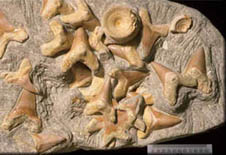A North Otago specimen of the extinct white shark Carcharodon angustidens is one of the most complete of its kind in the world. The fossil includes more than 150 teeth and many vertebrae (elements from the backbone). The shark was much larger and heavier than any living great white shark.
It is unusual to find a cluster of fossil teeth from one shark. Normally, fossil shark teeth are found isolated. The way in which teeth grow into place in living sharks explains the abundance of single fossil teeth. In living sharks, old teeth are shed regularly as new teeth move into position in the jaws. The shed teeth fall to the sea floor where, because they are formed of resistant minerals, they fossilise readily.
 Carcharodon teeth
Carcharodon teeth
Full sets of fossil shark teeth are extremely rare. In this case, the natural association of teeth and backbone elements represents the body of a single shark that was buried in quiet waters away from scavengers. The fossil was recovered from the transitional Kokoamu Greensand-Otekaike Limestone, dated at about ~26 M years. The original water depth was 50-100 m, judging from the nature of the rock and its contained fossils.
Carcharodon angustidens is related closely to the living white shark, Carcharodon carcharias, but differs in details of the teeth. One block of teeth and a single vertebra are shown in the adjacent figure (photo from Fordyce 2002). Technical details of the teeth are in the literature listed below.
This particular specimen, also, was larger than living white sharks. Proportions of teeth and vertebrae suggest that the animal was probably more than 9 m long and perhaps 8 tonnes in mass. Living white sharks reach about 6 m and ~1.2 tonnes.
The shark perhaps ate penguins, fish, dolphins, and baleen whales. Fossils of these animals occur in the same rocks as the shark.
This remarkable specimen is catalogued in the Geology Museum, University of Otago. The block of teeth figured here is displayed in the Geology Museum, University of Otago. The Geology Museum is open to the public 9am – 5 pm weekdays; access is via the Quadrangle.
A high-quality replica of the figured teeth is displayed in the Vanished World Centre, Duntroon, and the specimen is figured in the brochure for the Vanished World Trail.
Part of the fossil is on temporary loan to Otago Museum, Dunedin, where it may be seen in the Southern Lands, Southern People gallery.
References for further reading
- Gottfried, M.D. and Fordyce, R.E. 2001. An associated specimen of Carcharodon angustidens (Chondrichthyes, Lamnidae) from the Late Oligocene of New Zealand, with comments on lamnid interrelationships. Journal of vertebrate paleontology 21 (4): 730-739.
- Fordyce, R.E. 2002. Vanished world fossil trail, North Otago, New Zealand. Brochure published by Vanished World Inc., Duntroon.
- Keyes, I.W. 1972. New records of the elasmobranch C. megalodon (Agassiz) and a review of the genus Carcharodon in the New Zealand fossil record. New Zealand journal of geology and geophysics 15: 228-242.
- Klimley, A.P. and Ainley, D. G. (eds) 1996. Great white sharks: the biology of Carcharodon carcharias. Academic Press, San Diego. 517 p.
- Introduction
- Otago History
- Reptiles
- Dolphins
-
Sharks
- Carcharodon angustidens
- Whales
- Fossil penguins
-
Amphibians
-
Geological settings
- Vanished World Trail
- Geology Museum